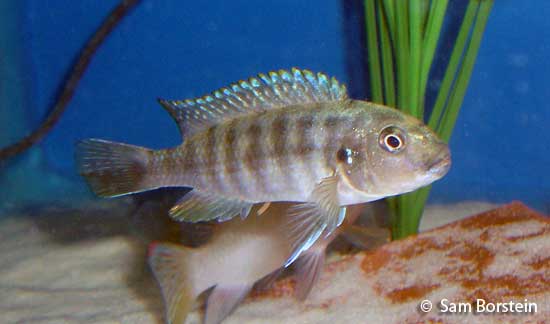Pseudotropheus sp. "perspicax orange cap"
Red Top Ndumbi
Synonyms: Pseudotropheus sp. "red top ndumbi"

Above: A displaying male Pseudotropheus sp. "perspicax orange cap". Female in background. Photo by Sam Borstein.
Etymology:
Genus- Pseudotropheus= False Tropheus (Latin).
Species- perspicax= with sharp eyes (Latin), orange cap= in reference to the orange blaze on the head.
Intro:
Pseudotropheus perspicax is a new, undescribed and popular maternal mouthbrooder. In the past few years, the This fish, is very similar to the species Pseudotropheus perspicax,and the undescribed species Pseudotropheus sp. "perspicax yellow breast", and Pseudotrophueus sp. "perspicax tanzania".Distribution:
Pseudotropheus sp. "perspicax orange cap" is found at Ndumbi and Pombo Reef in Lake Malawi.
Size, Maturity, and Sexual Dimorphism:
Size: Males- 4 inches, Females- 3 inches
Maturity: 2.5 inches
Sexual Dimorphism: Males are larger than females, and attain a purple/blue color with an orange blaze while females remain brown.

Above: A female Pseudotropheus sp. "perspicax orange cap". Photo by Sam Borstein.
Care:
Pseudotropheus sp. "perspicax orange cap" was not difficult to care for. I had them mixed with many different types of fish in a 50 breeder and had no problems. The fish is supposed to be non-aggressive in the wild and this was no different for me in aquaria, but I've heard many people say how nasty this fish is in their tanks.
Provide the fish with plenty of territory and crowd them. This will eliminate any problems with aggression if you have issues with a rogue male.
Diet:
This fish is an herbivore in the wild and feeds in a similar way to Labidochromis, nipping away at algae on rocks. Feed a balanced diet in captivity, but include a high quality veggie flake or pellet to it.
Breeding:
Red Top ndumbi are very easy to breed. Male color will intensify during breeding and look spectaculr. At this point they become territorial. The fish breed in the typical manner for Pseudotropheus.
Females are excellent holders and will hold term for about 20-22 days. The fry are small and range from 15-35. They grow quickly and by two months are over an inch in length. Raising the fry poses no problems.
Conclusion:
Pseudotropheus sp. "perspicax orange cap" is a very pretty and popular fish. You may be able to find this fish at a pet shop and it is available in hobbyist circles. I highly recommend this fish to any Malawi cichlid keeper.
References:
- Konings, A. (2007) Malawi cichlids in their natural habitat. 4th ed., Cichlid Press, El Paso, Texas, 424 pp.
